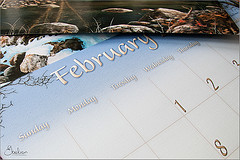
What’s On Your Calendar?
Mondays are productivity days at SimpleProductivity blog.
Calendars are such a common productivity tool that everyone thinks they know how to use them; yet just about every time I ask to see someone’s calendar, I find stuff on it that shouldn’t be there. So I ask you, what’s on your calendar?
Today we will look at what should go on a calendar, and where all that other stuff should live.
What Should Be On Your Calendar?
Calendars are repositories of events with a date and/or time.
Examples: your daughter’s orthodontist appointment; the furnace service repair appointment; Great Aunt Bertha’s birthday; the meeting to discuss increasing widget production, with the upper management of your company; your wedding anniversary; the special trash pickup date.
Do you see another common thread between these events? No, it isn’t that they have times – some of the events do not.
The common thread is that all of these things involve at least one other person.
The Types of Abuse
Yes, modern calendars allow you to link people to calendar events (meetings) and allow you to store notes with the events. But that doesn’t mean that you should. Here are some common abuses:
Notes
Most electronic calendars have a place to put notes. This is helpful if you wish to leave directions for where the meeting is. It is even a handy place to store a meeting agenda.
However, this is not where the information should live permanently. If you have a meeting agenda, and you need to refer to it beyond the next week, the meeting agenda should be pulled out into another document and saved with others of its type.
Why? So that you can find it quickly. It is much easier to look in a folder of meeting agendas, than to try to remember which of the weekly meetings had the one agenda item pertaining to the business at hand.
Meeting minutes should also not be stored in the calendar event either, for the same reason. You have to be able to refer to them later on, and it is easier to find them in a folder, rather than a calendar event.
Another advantage to saving agendas and minutes as a separate document: you can send those out to the people involved so that they have the information too. If it is stuck in your calendar, no one else can get at it.
Phone Numbers
Phone numbers may be relevant to a meeting – after all, some meetings occur over the phone. However, phone numbers are associated with a person, not a specific time and date. Phone numbers should be stored with the information about the person – such as in an address book. This makes it easy to find the information, outside of the context of a date and time.
A former client of mine routinely listed cell phone numbers for the teams in his meeting requests so that he would have the information on hand when he had to conference call them. However, he changed the data from meeting to meeting…and didn’t store the phone numbers outside of the meeting. So when a crisis came up and he had to call someone, he spent 20 minutes searching his calendar for the cell phone number instead of simply looking in his contacts.
With electronic address books, you can also quickly send contact information to other people.
Tasks
Tasks are a natural outcome for a meeting. You meet to discuss issues, and people are assigned to make things happen.
The tasks should be part of the meeting minutes (but not stored with the meeting data, see above). But they should also be given out so that the people who are responsible for completing those tasks do them. If the information is buried in a calendar entry, chances are the tasks won’t get done…out of sight, out of mind.
Two better ways of communicating tasks are to put the tasks into a shared task management system, assigning the work to the people responsible; or if that isn’t possible, sending out, possibly as part of the meeting notes, who is responsible for what.
Tasks can also show up as fake appointments…read on…
Fake Appointments
I know many productivity experts tell you that if you need time to get something done, you should put it on your calendar as an appointment with yourself, and honor it the same as an appointment with someone else.
It’s a good theory, but I disagree with it because it rarely works. Most people will realize that it is an appointment without any meaning, and blow through it. It takes a great deal of self-discipline to make this work, and in my experience most people (myself included) don’t have that level of self-discipline.
One time I do agree to using fake appointments is to convey to others when you will be busy. For example, my work schedule is such that I leave 1.5 hours before most people. For many months, even though my working hours were set in Outlook, people would schedule meetings for me after I left for the day. In order to prevent that, I simply put in a daily appointment that shows I am out of the office from 3:30 to 5 pm. This prevents people from scheduling meetings during that time, because Outlook plainly shows that I am not available.
Appointments You Don’t Have To Remember
As an database programmer, I can tell you that the information you get out of a system is only as good as the information you get into the system. If you don’t put things in, you can’t get them out. And it is better to have too much information in the system than not have enough.
Many people don’t put things in their calendar because they think they will remember them. This is great if you have a fabulous memory, but what if you forget? Or what if you need to pull a bunch of similar information from your calendar – the stuff you have memorized won’t show up. Or what if someone else is using your calendar?
An example of this is a birthday. You might not have to remember your spouse’s birthday, but what if you wanted to quickly pull a list of birthdays to give to a new family member who asked? Your spouse wouldn’t be on that list. Or what if your 5-year-old wanted to know when the birthday was to prepare a surprise?
As a rule of thumb, it is best to put all appointments in the calendar, even if you think you can remember them, so that you have a complete list of events, both past and present, and others can use that information.
How To Spot Them
So now we have looked at what the calendar abuses are. Let’s look at how to spot them.
Go through your calendar, and look for the following items:
- Is it an appointment with other people? If not, ask yourself why it is there, and remove it if there is no good reason.
- Does it have information that needs to be stored elsewhere? If there are notes, move them out. Put phone numbers in an address book. Pull tasks into a place where the people concerned can get information.
- Is there anything missing? Are there things you remember but aren’t in the calendar? Put them in.
A Word About Multiple Calendars
As an aside, I wanted to mention maintaining multiple calendars. I believe that personal information should not go on a work calendar, unless it directly impacts your work.
Why? People who are not concerned can access work calendars. (And don’t think calendars are secure because there are ways around that. Trust me.)
For instance, if you had an appointment to treat a foot fungus, would you want that detail on your work calendar for all to see? (I hope not.) It would be better to maintain the details in your personal calendar, and then make a generic out of office appointment on your work calendar – people would know you were out of the office, but not why.
If you are worried about seeing all of your appointments in one place, there are ways to pull in information from your personal and work calendar to one place, but that is a subject for another article.
How much stuff is on your calendar that should be elsewhere? How much stuff is in your head and not on your calendar? Your challenge for this week is to look at the past two weeks of calendar items, and the upcoming two weeks of appointments and figure out if you have things out of place.
Photo by -Ebelien-. Licensed under Creative Commons.




